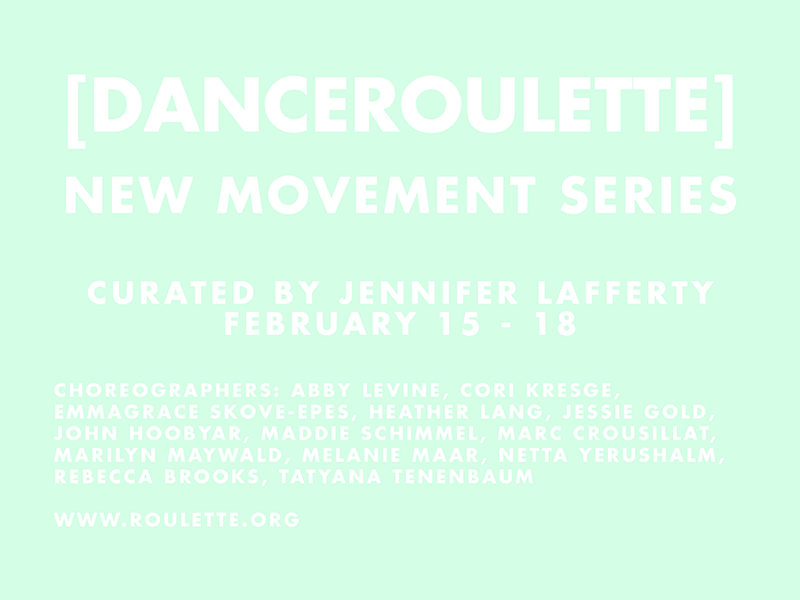Jennifer Lafferty In Conversation with Alexis Convento
Since 2014, dancer and curator Jennifer Lafferty has invited choreographers to present as part of [DANCEROULETTE]’s New Movement Series. As she begins her fourth season this February, Alexis Convento, curator of the CURRENT SESSIONS contemporary performance series, speaks to Jennifer about the “emerging” artist, non-curation, and fluidity between curatorial and performance roles.
Alexis Convento: Hi Jennifer, thank you for taking the time. I’m excited to speak with someone else who moves between artistic and curatorial roles. Having experience on both sides can bring a lot to a curatorial practice. To begin, I’d like to learn a little more about how you started with the New Movement Series.
Jennifer Lafferty: It was good timing, really. The New Movement Series was my first curatorial opportunity. Most days I still call myself a performer–I work with a number of choreographers, most recently Rebecca Lazier and Beth Gill. But I also try to see as much performance as possible. I love how many ways dance can be presented to the audience. Works-in-progress at Movement Research, mixed-bills at Center for Performance Research, and seasoned choreographers at The Kitchen, New York Live Arts, and The Chocolate Factory… I try to see as much as I can. The city is always changing and filled with good ideas. After each performance, I like to start a conversation about the choreography presented. This is what led me to where I am now. After seeing one another at several shows, a former Roulette curator reached out about programming the New Movement Series. This was back in 2014, and February will now be my fourth series.
AC: Yes, great timing. So tell me more about the New Movement Series. What artists are involved? What sets this series apart?
JL: The New Movement Series was established as an “emerging” artist platform. I found that term a bit challenging at first and spent a lot of time trying to define for myself who I considered an “emerging” artist. Ultimately I decided to interpret the term broadly and focus on young artists who can create suspense through movement and experiment with different techniques. What’s most important is that I find choreographers who are always curious. It doesn’t matter to me if artists are classically-trained, but rather that they are immersed in a personal practice, and that they continuously explore their craft.
And to answer your second question, what separates New Movement is that I try to work towards an idea of non-curation. I think it’s particularly important when working with artists in the early stages of their choreographic development–
AC: –I’m so used to doing just the opposite. Whenever I put together a show I am always searching for a through-line, trying to fit narratives and themes together. It’s nice that you can let go of control in that way. Can you elaborate on what you mean by non-curation? Why is it crucial for emerging platforms like the New Movement Series?
JL: There are so many practices out there, I want to let them come into contact with one another. As an organizer, I try to listen and keep an open mind. I also think it’s important to provide opportunities for emerging artists. With New Movement I want to give young artists the space they need to explore, make mistakes, and take risks. To allow room for failure as part of the research in early stages of making. If these choreographers have the opportunity to explore it’s unfair for me to limit their creativity by restricting them to a certain concept, style, or focus. My first concern is to provide the resources, time, space, and personnel, for these artists. What I ask in return is trust, transparency, and a shared commitment to the presentation of great dance for an audience that is curious.
AC: It is important to make space for artists in early stages of development. Okay, last question: I feel like this may come naturally for you because you’re often around other artists, but how do you think the part of the curator differs from that of the performer. Do you find it challenging to switch between roles?
JL: Luckily, as a performer, I find myself among people who are constantly investigating, pulling apart, and discussing performance in a multitude of ways. This contact allows me to learn about new movement, and encounter artists as they are building work.
A question that I often revisit is how much my own aesthetic should read within the New Movement Series. I try to find balance by letting the space between performer and curator remain fluid while organizing evenings that allow for multiple perspectives and entry points.
[DANCEROULETTE]’S New Movement Series runs from February 15-18, 2017, and presents choreography by Abby Levine, Anonymous – Cori Kresge, EmmaGrace Skove-Epes, Jessie Gold, John Hoobyar, Maddie Schimmel, Marc Crousillat, Marilyn Maywald, Melanie Maar, Netta Yerushalmy and Marc Crousillat, Rebecca Brooks, and Tatyana Tenenbaum.

